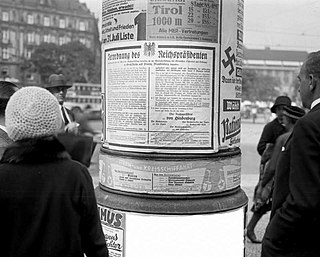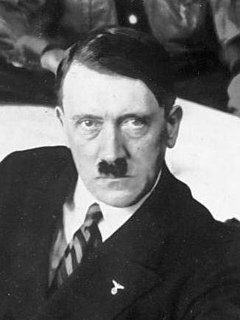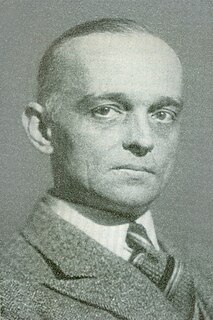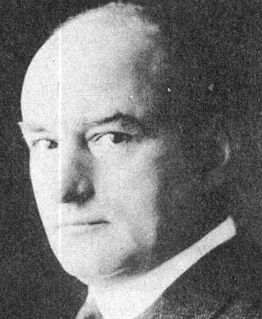Related Research Articles

The Night of the Long Knives, or the Röhm purge, also called Operation Hummingbird, was a purge that took place in Nazi Germany from June 30 to July 2, 1934. Chancellor Adolf Hitler, urged on by Hermann Göring and Heinrich Himmler, ordered a series of political extrajudicial executions intended to consolidate his power and alleviate the concerns of the German military about the role of Ernst Röhm and the Sturmabteilung (SA), the Nazis' paramilitary organization, known colloquially as "Brownshirts". Nazi propaganda presented the murders as a preventive measure against an alleged imminent coup by the SA under Röhm – the so-called Röhm Putsch.

Franz Joseph Hermann Michael Maria von Papen, Erbsälzer zu Werl und Neuwerk was a German conservative politician, diplomat, Prussian nobleman and General Staff officer. He served as the chancellor of Germany in 1932, and then as the vice-chancellor under Adolf Hitler from 1933 to 1934.

The Centre Party, officially the German Centre Party and also known in English as the Catholic Centre Party, is a Catholic political party in Germany, influential in the German Empire and Weimar Republic. It is the oldest German political party to be still in existence since its founding date. Formed in 1870, it successfully battled the Kulturkampf waged by Chancellor Otto von Bismarck against the Catholic Church. It soon won a quarter of the seats in the Reichstag, and its middle position on most issues allowed it to play a decisive role in the formation of majorities. The party name Zentrum (Centre) originally came from the fact Catholic representatives would take up the middle section of seats in parliament between liberals and conservatives.

The Reichskonkordat is a treaty negotiated between the Vatican and the emergent Nazi Germany. It was signed on 20 July 1933 by Cardinal Secretary of State Eugenio Pacelli, who later became Pope Pius XII, on behalf of Pope Pius XI and Vice Chancellor Franz von Papen on behalf of President Paul von Hindenburg and the German government. It was ratified 10 September 1933 and it has been in force from that date onward. The treaty guarantees the rights of the Catholic Church in Germany. When bishops take office Article 16 states they are required to take an oath of loyalty to the Governor or President of the German Reich established according to the constitution. The treaty also requires all clergy to abstain from working in and for political parties. Nazi breaches of the agreement began almost as soon as it had been signed and intensified afterwards leading to protest from the Church including in the 1937 Mit brennender Sorge encyclical of Pope Pius XI. The Nazis planned to eliminate the Church's influence by restricting its organizations to purely religious activities.

Edgar Julius Jung was a German lawyer born in Ludwigshafen in the Kingdom of Bavaria.
The early timeline of Nazism begins with its origins and continues until Hitler's rise to power.

The Hitler cabinet was the government of Nazi Germany between 30 January 1933 and 30 April 1945 upon the appointment of Adolf Hitler as Chancellor of the German Reich by president Paul von Hindenburg. It was originally contrived by the national conservative politician Franz von Papen, who reserved the office of the Vice-Chancellor for himself. Originally, Hitler's first cabinet was called the Reich Cabinet of National Salvation, which was a coalition of the Nazi Party (NSDAP) and the national conservative German National People's Party (DNVP).

Michael Cardinal Ritter von Faulhaber was a German Catholic prelate who served as Archbishop of Munich for 35 years, from 1917 to his death in 1952. Created Cardinal in 1921, von Faulhaber criticized the Weimar Republic as rooted in treason in a speech at the 62nd German Catholics' Day of 1922. Cardinal von Faulhaber was a leading member and co-founder of the Amici Israel, a priestly association founded in Rome in 1926 with the goal of advocating Jewish-Christian reconciliation.

The 1932 Prussian coup d'état or Preußenschlag took place on July 20, 1932, when Reich President Paul von Hindenburg, at the request of Franz von Papen, then Reich Chancellor of Germany, invoked Article 48 of the Weimar Constitution to replace the legal government of the Free State of Prussia by von Papen as Reich Commissioner. A second decree the same day transferred executive power in Prussia to the Reich Minister of the Armed Forces Kurt von Schleicher and restricted fundamental rights.

Federal elections were held in Germany on 6 November 1932. The Nazi Party saw its vote share fall by four percentage points, while there were slight increases for the Communist Party of Germany and the national conservative German National People's Party. The results were a great disappointment for the Nazis, who lost 34 seats and again failed to form a coalition government in the Reichstag. The elections were the last free and fair all-German election before the Nazi seizure of power in 1933.

Franz Gürtner was a German Minister of Justice in the governments of Franz von Papen, Kurt von Schleicher and Adolf Hitler. Gürtner was responsible for coordinating jurisprudence in the Third Reich and provided official sanction and legal grounds for a series of repressive actions under the Nazi regime from 1933 until his death in 1941.

Alois Karl Hudal was an Austrian bishop of the Catholic Church, based in Rome. For thirty years, he was the head of the Austrian-German congregation of Santa Maria dell'Anima in Rome and, until 1937, an influential representative of the Catholic Church in Austria.

Adolf Hitler's rise to power began in the newly established Weimar Republic in September 1919 when Hitler joined the Deutsche Arbeiterpartei – DAP. Hitler rose to a place of prominence in the early years of the party. Being one of its best speakers, he was made the party leader after he threatened to otherwise leave.

Carl Fedor Eduard Herbert von Bose was head of the press division of the Vice Chancellery (Reichsvizekanzlei) in Germany under Vice Chancellor Franz von Papen. A conservative opponent of the Nazi regime, Bose was murdered during the Night of the Long Knives in the summer of 1934.

Peter Paul Freiherr von Eltz-Rübenach was Reich Postal Minister (Reichspostminister) and Reich Minister of Transport (Reichsminister für Verkehr) of Germany between 1932 and 1937.

Cesare Vincenzo Orsenigo was Apostolic Nuncio to Germany from 1930 to 1945, during the rise of Nazi Germany and World War II. Along with the German ambassador to the Vatican, Diego von Bergen and later Ernst von Weizsäcker, Orsenigo was the direct diplomatic link between Pope Pius XI and Pope Pius XII and the Nazi regime, meeting several times with Adolf Hitler directly and frequently with other high-ranking officials and diplomats.

Popes Pius XI (1922–1939) and Pius XII (1939–1958) led the Catholic Church during the rise and fall of Nazi Germany. Around a third of Germans were Catholic in the 1930s, generally in southern Germany; Protestants dominated the north. The Catholic Church in Germany had opposed the Nazi Party, and in the 1933 elections, the proportion of Catholics voting for the Nazi Party was lower than the national average. Nevertheless, the Catholic-aligned Centre Party voted for the Enabling Act of 1933, which gave Adolf Hitler additional domestic powers to suppress political opponents in Germany as Chancellor. President Paul Von Hindenburg continued as Commander and Chief and responsible for negotiation of international treaties until his death, 2 August 1934.

Formal diplomatic relations between the Holy See and the current Federal Republic of Germany date to the 1951 and the end of the Allied occupation. Historically the Vatican has carried out foreign relations through nuncios, beginning with the Apostolic Nuncio to Cologne and the Apostolic Nuncio to Austria. Following the dissolution of the Holy Roman Empire and the Congress of Vienna, an Apostolic Nuncio to Bavaria replaced that of Cologne and that mission remained in Munich through several governments. From 1920 the Bavarian mission existed alongside the Apostolic Nuncio to Germany in Berlin, with which it was merged in 1934.
Franz Justus Rarkowski, S.M. was the Catholic military bishop of Nazi Germany. The existence of such a role was provided for by the Reichskonkordat (1933), and Rarkowski had been acting head of the military chaplaincy since 1929, before he was officially consecrated on February 29, 1938 as episcopus castrensis. Rarkowski's title was translated into English as "Field Bishop of the German Army".

The Federal State of Austria was a continuation of the First Austrian Republic between 1934 and 1938 when it was a one-party state led by the clerical fascist Fatherland Front. The Ständestaat concept, derived from the notion of Stände, was advocated by leading regime politicians such as Engelbert Dollfuss and Kurt Schuschnigg. The result was an authoritarian government based on a mix of Italian Fascist and conservative Catholic influences.
References
- 1 2 3 4 Robert Anthony Krieg. Catholic Theologians in Nazi Germany. London, England, UK: Continuum International Publishing Group, 2004. Pp. 4.
- 1 2 Robert P. Ericksen. Complicity in the Holocaust: Churches and Universities in Nazi Germany. Cambridge University Press, 2012. Pp. 57.
- 1 2 Guenter Lewy. The Catholic Church And Nazi Germany. Da Capo Press, 1964. Pp. 46.
- ↑ Guenter Lewy (2000). The Catholic Church And Nazi Germany. Da Capo Press. pp. 46–. ISBN 978-0-7867-5161-7 . Retrieved 13 March 2013.